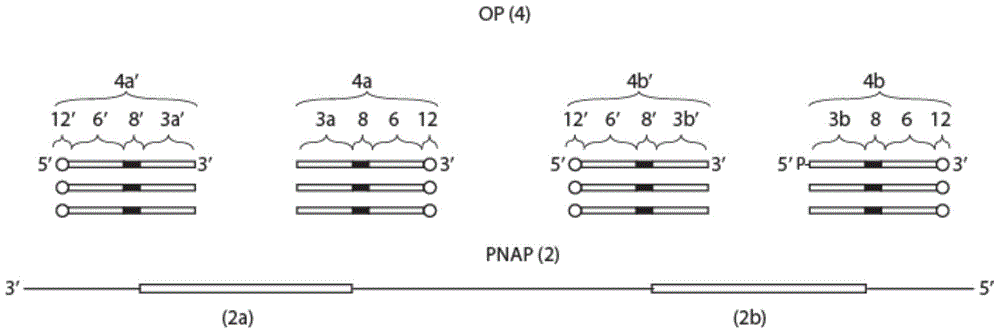Method for the simultaneous amplification of a plurality of different nucleic acid target sequences
A nucleotide sequence and target sequence technology, applied in the field of DNA or RNA library, nucleic acid polymer library, can solve the problems of primer incompatibility, difference in amplification efficiency of different targets, etc.
- Summary
- Abstract
- Description
- Claims
- Application Information
AI Technical Summary
Problems solved by technology
Method used
Image
Examples
Embodiment 1
[0154] Oligonucleotide probes were designed to target three genomic locations of the calpain-3 gene, exon 17, exons 18 and 19, and exon 22, as image 3 shown. For each target region, a first oligonucleotide probe ("reverse oligo") and a second oligonucleotide probe ("forward oligo") were synthesized. Oligonucleotide probes are shown in Table 1 below.
[0155] Reverse oligonucleotide probes (for each exon, CAPN3_Exon17_Reverse_ET1, CAPN3_Exon18-19_Reverse_ET5 and CAPN3_Exon22_ Reverse_ET1) is phosphorylated at the 5' end and contains a portion of the target sequence complementary to the original target sequence, the efficiency tag sequence (underlined), the universal reverse primer annealing sequence, and six phosphorothioates at its 3' end Nylated nucleotide analogs (indicated by an asterisk).
[0156] Forward oligonucleotide probes (CAPN3_exon17_forward_ET1, CAPN3_exon18-19_forward_ET5, and CAPN3_exon22_forward_ET1) contained their 5 The 6 phosphorothioated nucleotide ana...
Embodiment 2
[0167] result
[0168]As a model we chose the human dystrophin gene, the largest (not exon wise, but coverage wise) known human being consisting of 79 exons Gene. Since Chamberlain first reported multiplex PCR, the dystrophin gene has also been used as a multiplex PCR model by other investigators. To build our new technology, we utilized ExonPrimer to design 78 different targets covering all 79 exons. To enable rapid analysis by gel electrophoresis, we selected 12 targets of different sizes that were easily discernible when resolved on the gel ( Figure 5 ). The size of the selected targets ranged from 153bp to 725bp ( Figure 5 ).
[0169] To demonstrate the ability of etPCR to control PCR efficiency, we first generated by PCR a single template containing an efficiency tag and a common priming sequence ( Figure 5 ). The gel-purified template was subjected to quantitative PCR to analyze PCR efficiency ( Figure 6 a). We first performed standard qPCR using a universe ...
PUM
 Login to View More
Login to View More Abstract
Description
Claims
Application Information
 Login to View More
Login to View More - R&D
- Intellectual Property
- Life Sciences
- Materials
- Tech Scout
- Unparalleled Data Quality
- Higher Quality Content
- 60% Fewer Hallucinations
Browse by: Latest US Patents, China's latest patents, Technical Efficacy Thesaurus, Application Domain, Technology Topic, Popular Technical Reports.
© 2025 PatSnap. All rights reserved.Legal|Privacy policy|Modern Slavery Act Transparency Statement|Sitemap|About US| Contact US: help@patsnap.com



